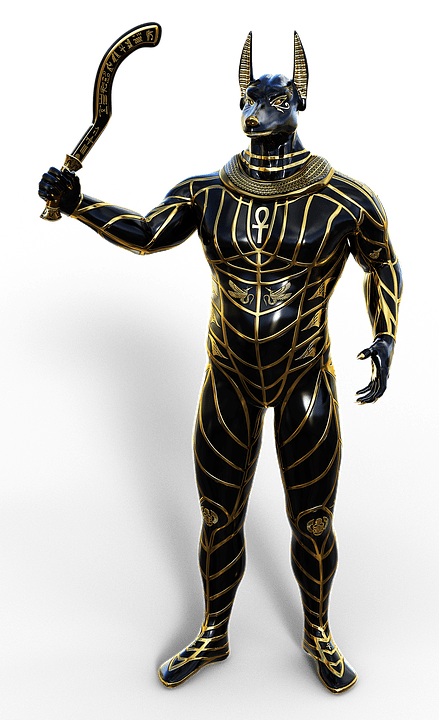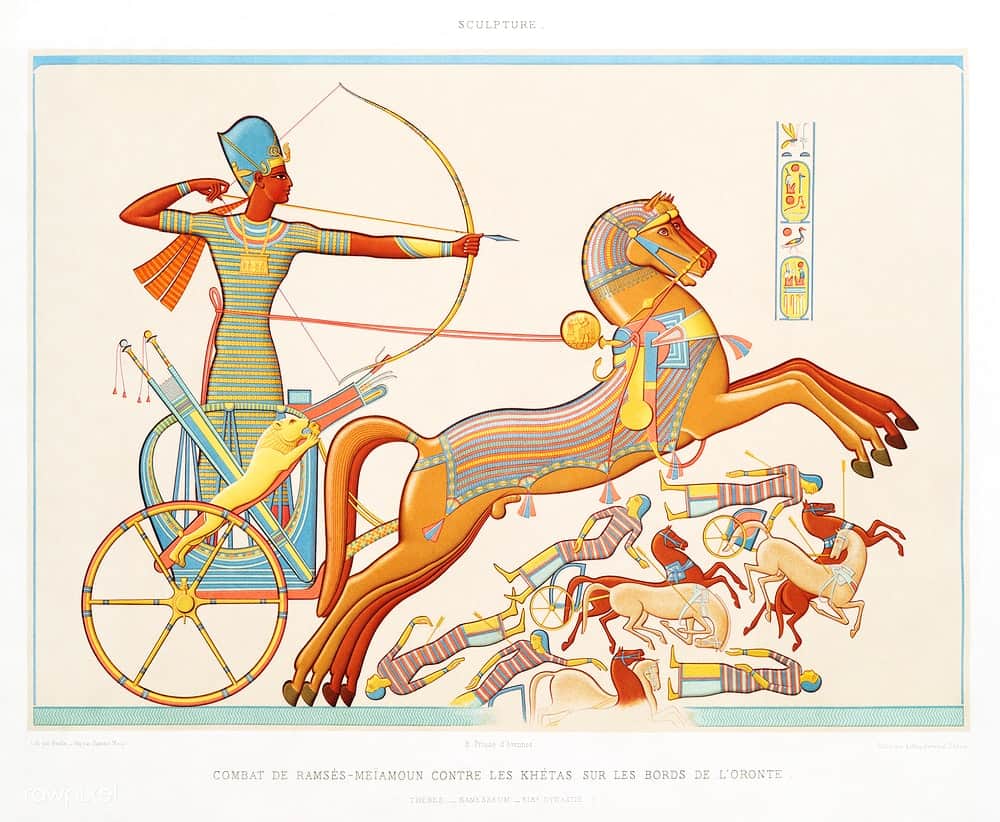Egyptian mythology emerged around 4000 BC.
Egyptians would incorporate mythology into their burial rituals and art. They believed the earth was formed by Heka, the God of magic and that the earth was surrounded by Nu, the God of water.
Atum is known as the first self-made deity of Egyptian mythology. Atum gave birth to two children: Shu, the Egyptian God of air, and Tefnut, the Egyptian Goddess of moisture. Thus, Egyptian mythology and the earth were formed.
This is where everything began. 8000 years later, we’re going to dive deep into the Egyptian myths that shaped one of the most ancient civilizations on Earth.
The Myth of Isis and Osiris
Isis, the Egyptian goddess of life, protects women, children, and the sick. She was married to her brother, Osiris, who was the Egyptian God of the dead.
The latter became a great leader of the Egyptians but his brother Seth grew extremely jealous.
Seth finally developed a plan to get rid of his brother. He created a chest that was made to fit the God of the dead.
He made it with ivory and adorned it with gold and silver, creating paintings of birds and animals. The conspirators that accompanied Seth each tried on the chest, knowing it would not fit any of them.
Once Osiris tried on the chest, he was elated to see it fit him perfectly! Seth then poured molten lead into the chest and threw Osiris into the Nile to drown.
Seth became the king of Egypt, but Isis was heartbroken. She desperately missed her husband and went searching for his body. Isis found the body of Osiris on the coast of the Mediterranean Sea and brought him back to Egypt.

Seth was infuriated that his enemy had returned, so he took his vengeance out on his body and chopped it up into many tiny pieces, and scattered them across the 4 corners of the Earth.
Isis transformed into a bird and asked her sister, Nephthys, to help her.
Piece by piece, Isis, and Nephthys recovered all of the pieces of Osiris and put him back together using a mixture of magic and bandages.
Fearful that Osiris would be taken from her once more, she embalmed his body with the help of Anubis and hid him away in a safe place that only she knew.
A few months later, Isis gave birth to their son, Horus, whom she hid in the marshesm of the Nile River so that he could become fully grown and overthrow Seth from the throne of Egypt. Horus eventually grew into a man and took over the throne of Egypt.
The story of Isis and Osiris teaches us that Isis embodies the characteristics that the Egyptian wife and mother should possess, and that the son should avenge his father when necessary.
Anubis: The Guardian of the Dead
The story of Isis and Osiris brings mention of Anubus, the Egyptian God of mummification, embalming, and the afterlife. Anubis is described as having the body of a man with the head of a jackal.
Because of this, priests wore masks with a jackal face during the mummification and embalming process to pay homage to Anubis.

It is also said that organ donation began with Anubis in Egyptian mythology because part of the body of Osiris was given to Anubis after he died.
Jackals are known to dig up bodies that have been buried and eat the remains, causing a disturbance to those who have been laid to rest. Because of this, Anubis became the protector of cemeteries to ensure that the dead were never disturbed.
The Girl with the Rose Red Slippers Myth
Once there was a girl who was brought to a land called Naucratis to be sold to the highest bidder. In that city was a wealthy Greek merchant named Charaxos.
He was in the marketplace when he noticed a crowd had begun gathering. By maneuvering his way to the front of the crowd, where he saw a beautiful girl who had been brought to the stone to be auctioned.
Enamored with her beauty with extremely wealthy, Charaxos easily purchased her. He discovered the girl’s name was Rhodopis, and she was a slave with a man named Aesop, who told her outlandish stories of animals and people. Now, Rhodopis was old enough to be sold as a slave.
Charaxos was intrigued by her life’s story and decided to give her a comfortable life. He gave her a beautiful house with servants, along with a garden pool, beautiful clothes, and her favorite rose-red slippers.
The Slippers of Rhodopis
One day as Rhodopis was cooling off in the pool, an eagle swooped down and began attacking the servants who were guarding Rhodopis’s belongings, including her beloved rose-red slippers.
The servants scattered and took cover to protect themselves, leaving the clothes, jewels, and slippers behind. The eagle picked up one of the rose-red slippers and flew away.
Rhodopsin was devastated that she had lost one of the gifts that Charaxos had given her, especially because it was the rose-red slippers that she loved so very much.
In a nearby city, the Pharoh Amasis was sitting on his throne when an eagle flew up and dropped the rose-red slipper before him.
Amasis could not believe a rose-red slipper had just been dropped in his lap, and he was convinced the slipper belonged to the most beautiful girl in the world.
He told his people that they must take the shoe and find the woman to whom the shoe belonged and tell her that she must be the bride of the Pharoh.
Everyone did as they were told and went searching for the woman.
They learned there was a wealthy merchant who had bought a slave in the market and gave her anything she wanted, so they went to visit Charaxos. Here, they found Rhodopis in her garden beside the pool and presented her with the shoe.
Rhodopis was elated and asked her servant to bring the other shoe that she had kept after the eagle had stolen.
She held out her foot, and the shoe slipped on perfectly. She was the woman they’ve been looking for.
The people bowed before her and told her why they were there. They explained that the Pharoh Amasis had been sent the rose-red slipper and vowed that the woman whose foot fits into the rose-red slipper must be his bride.
Rhodopis understood this command and told Charaxos goodbye. She went with the people back to the city of Memphis, where the Pharoh lived.
When Pharoh Amasis saw Rhodopis, he knew that she was sent to him from the gods. Pharoh Amasis immediately made her the queen and the royal lady of Egypt, where they lived in harmony until their death.
Bastet: The Worship of Cats
In Egyptian mythology, Bastet was the Egyptian goddess of the home, fertility, childbirth, and cats.
Bastet is depicted as a woman with the head of a lioness, which is how the Egyptians came to worship cats.
Egyptians honored Bastet and everything she did for the home, children, and women, so her depiction of having a head of a cat only deepened their love for the animal.
Bastet came to have two titles: The Lady of Dread and The Lady of Slaughter.
Because Bastet had the head of a cat and the body of a woman, she was known for being both passive and aggressive. Bastet was known to be the protector of the king, which is why cats became a common domestic animal that Egyptians came to love.
Because Bastet is worshipped in Egyptian mythology, the cat was commonly seen on artwork and in statues. Sometimes Bastet is shown in her true form with a woman’s body and a lioness head. Other times, Bastet is shown as a tall cat with long legs.
Today, it is extremely like that you will see Bastet, cats, or other cat-like features on Egyptian artwork.
Conclusion
Egyptian mythology plays a large role in Egyptian history. Through Egyptian mythology, cultures learned how to embalm, mummify, and protect the dead.
Whether it is through Anibus, the jackal who helped discover embalming, or Bastet, the Egyptian goddess of the home, women, and children who had a lioness head on a woman’s body, it is extremely likely to find these important mythical features on Egyptian artwork even today.
I’ve been intrigued by my dreams (we’re talking night-time ones) from a young age, and have decided to take some steps to inquire deeper into this fascinating, mysterious realm. Join me?

I just wish there were moremyths